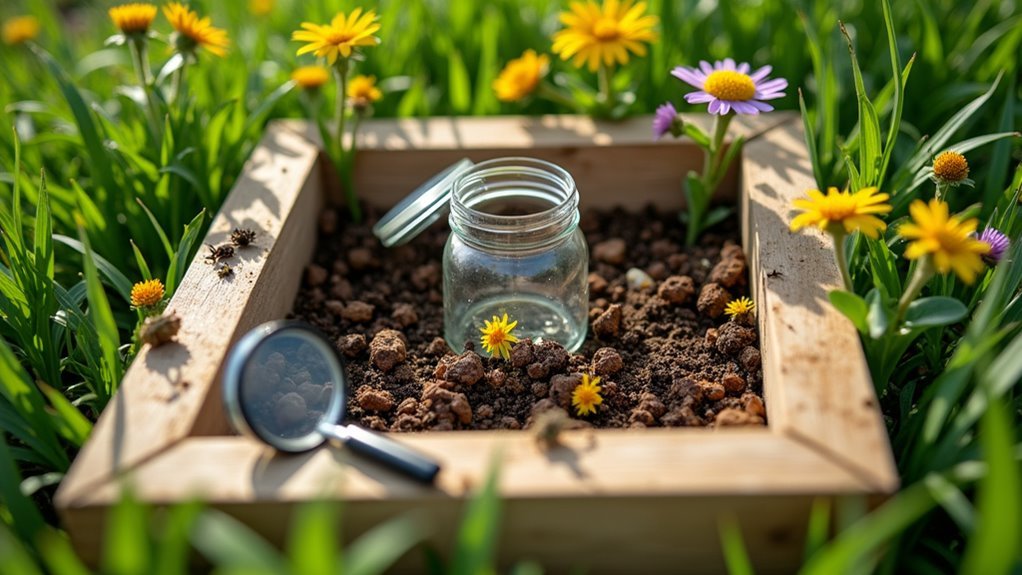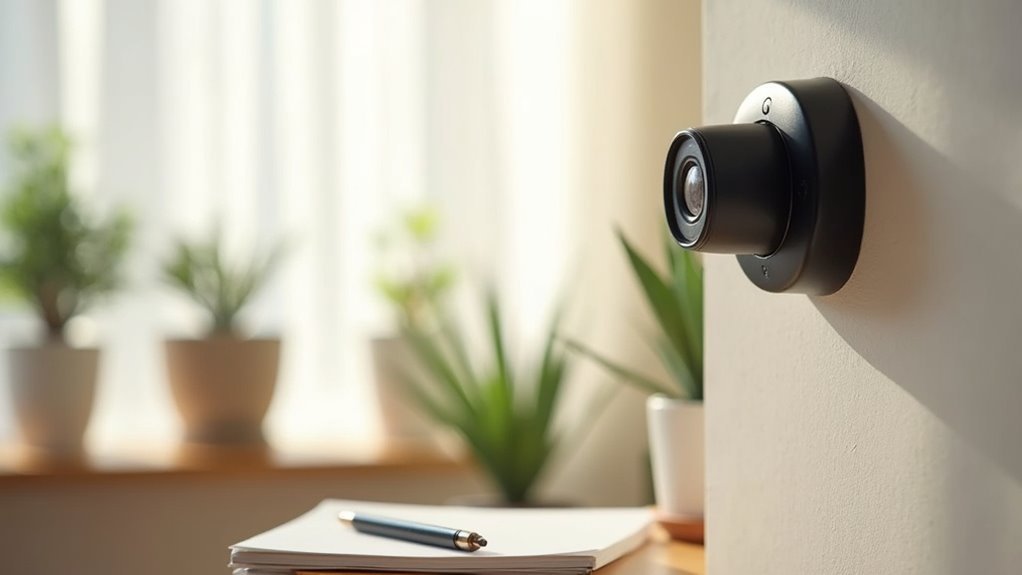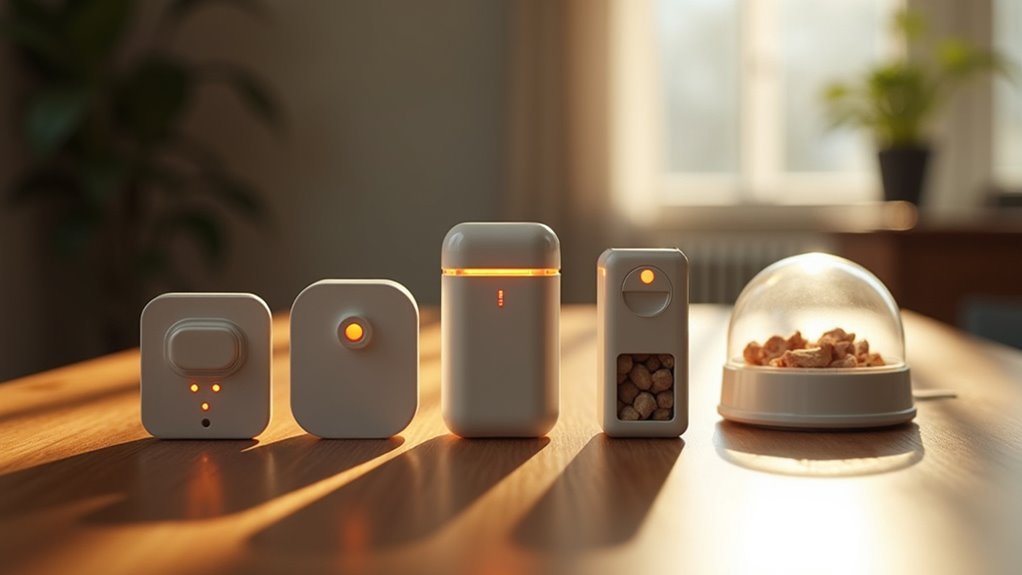You can create an effective backyard insect monitoring station by strategically placing In2Care® mosquito traps near breeding sites and adding sticky traps for flying insects in shaded areas. Position your equipment away from direct sunlight and strong winds, ensuring easy access for maintenance every 4-6 weeks. Install weather-resistant covers with proper drainage to protect your devices from rain and moisture. Establish weekly inspection routines to track pest activity and identify problem areas before infestations develop into serious issues.
Essential Components for Your Monitoring Station Setup

Although setting up an effective insect monitoring station might seem complex, you’ll find success by focusing on a few key components that work together to track and control pest populations.
Start with In2Care® mosquito traps as your foundation – these specialized devices disrupt mosquito reproductive cycles and provide targeted pest control. Complement these with sticky traps and visual lures to capture diverse insect species and assess activity patterns throughout your yard.
You’ll need regular replacement supplies including fresh water and biocide-treated gauze to maintain trap effectiveness. These monitoring tools require maintenance every 4-6 weeks for ideal performance.
Position everything in shaded, vegetated areas where mosquitoes naturally congregate. This strategic placement maximizes your station’s ability to attract and monitor various insect populations while providing thorough data for your pest management efforts.
Selecting the Perfect Location in Your Yard
With your monitoring equipment selected, you’ll need to find the right spot in your yard where these tools can perform most effectively.
Choose a shaded location away from direct sunlight, as insects prefer cooler, damp environments for breeding grounds and resting. Position your monitoring station near areas where you’ve observed insect activity, such as around plants or standing water sources.
Ascertain the location remains accessible for regular checks and maintenance by keeping it within a few feet of pathways or your home. Avoid placing the station next to strong-smelling plants or flowers that could attract specific insects and skew results.
Select an area protected from strong winds and heavy foot traffic to minimize disturbances affecting insect behavior and monitoring accuracy.
Types of Traps and Detection Devices to Include

Sticky traps offer visual monitoring capabilities, capturing flying insects while indicating pest presence levels.
Light traps effectively target night-flying species using ultraviolet attraction.
Larvae monitoring devices detect immature mosquitoes in standing water, enabling early intervention strategies before adult emergence threatens your outdoor comfort.
Building Sticky Trap Systems for Flying Insects
Among the monitoring options available, sticky traps provide the most straightforward approach for tracking flying insect populations in your backyard.
You’ll want to construct these monitoring devices using durable materials like recycled polypropylene for the base structure. Position your traps strategically in shaded, vegetated areas where mosquitoes and flies typically congregate, especially near standing water breeding sites.
For enhanced effectiveness, incorporate biocide-treated gauze alongside the adhesive surfaces. This addition disrupts mosquito reproductive cycles while maintaining your monitoring capabilities.
Replace the sticky surfaces every 4-6 weeks to guarantee peak performance and accurate insect activity data.
Strategic placement near known breeding sites maximizes catch rates, providing valuable insights into population trends and helping you make informed decisions about additional control measures.
Creating Ground-Level Monitoring Points for Crawling Pests

You’ll need to master strategic trap placement methods that target high-activity zones where crawling pests naturally travel and congregate.
Your monitoring equipment selection becomes essential since different crawling species require specific trap types and bait attractants to achieve reliable capture rates.
Ground pest identification techniques will help you distinguish between various species caught in your traps, enabling you to implement targeted control strategies for each pest type.
Strategic Trap Placement Methods
While many homeowners focus on aerial pest control, establishing ground-level monitoring points creates the foundation for thorough crawling pest management. Your trap placement strategy determines success—position traps in shaded areas where pests seek refuge and near breeding grounds like stagnant water or overgrown vegetation.
| Location Type | Pest Activity Level | Monitoring Priority |
|---|---|---|
| Shaded garden corners | High | Critical |
| Near water sources | Very High | Essential |
| Under decking | Moderate | Important |
| Overgrown vegetation | High | Critical |
| Mulched areas | Moderate | Important |
Create multiple monitoring points throughout your property to establish an effective surveillance network. You’ll need to check traps regularly and replace bait as needed. Consider eco-friendly traps like In2Care® Mosquito Traps that target pests while protecting beneficial insects and maintaining environmental balance.
Effective Monitoring Equipment Selection
Three essential trap types form the backbone of effective ground-level monitoring: bait stations, glue boards, and eco-friendly systems like In2Care® Mosquito Traps.
You’ll want to strategically deploy these mosquito control solutions to monitor different pest populations targeting your backyard’s specific vulnerabilities.
Bait stations excel at attracting crawling insects like ants and beetles, while glue boards capture various flying and crawling pests without chemicals.
In2Care® traps offer effective solutions requiring minimal maintenance—simply refill attractants and replace saturated traps every 4-6 weeks.
Document captured insects by type and quantity to assess your monitoring station’s performance.
This data helps you identify infestation patterns and adjust your equipment selection accordingly.
Regular maintenance guarantees ideal trap functionality and provides reliable pest population insights.
Ground Pest Identification Techniques
Where should you position monitoring stations to capture the most thorough data about crawling pests in your yard? Effective ground pest identification techniques require strategic placement in shaded, moist areas where ants and cockroaches typically thrive.
Your monitoring approach should include:
- Strategic placement – Position sticky traps and bait stations in areas that naturally attract crawling pests.
- Regular inspection – Check monitoring points frequently for captured insects or chewed bait to assess infestation severity.
- Documentation tracking – Record pest types and numbers at each location to identify population trends.
You’ll want to monitor pest activity using both organic and synthetic baits to attract diverse ground pests while protecting beneficial insects.
Rotate station locations every few weeks to track moving populations effectively, ensuring your pest control strategies remain extensive and informed.
Installing Weather Protection for Your Equipment
You’ll need to protect your monitoring equipment from Houston’s harsh weather conditions to guarantee accurate data collection and extend equipment life.
Start by selecting waterproof enclosures that can handle the region’s high humidity and frequent rainfall, then establish proper drainage systems around your stations to prevent water accumulation.
Don’t forget to schedule regular maintenance of your protective covers, as consistent upkeep is essential for long-term monitoring success in challenging outdoor environments.
Weatherproof Housing Selection
Although your insect monitoring equipment might function perfectly in controlled indoor conditions, it’ll face serious challenges once exposed to outdoor elements.
You’ll need weatherproof housing that can handle your local climate, especially the humidity and heat common in regions like Houston, Texas.
When choosing your protective enclosure, prioritize these essential features:
- UV-resistant materials with moisture protection – Look for housings that won’t degrade under constant sunlight and rain exposure.
- Proper ventilation with drainage systems – Guarantee air circulation prevents overheating while allowing water to exit quickly.
- Easy access design – Choose enclosures that let you perform maintenance services and data retrieval without compromising protection.
Select housing that keeps your equipment secure from pests while remaining accessible for regular upkeep.
Drainage System Setup
Water damage poses one of the greatest threats to your monitoring equipment, making proper drainage installation a critical step in protecting your investment.
You’ll need perforated pipes and gravel to create an effective drainage system that diverts excess water away from your station while allowing proper seepage. Install these components around your monitoring area, guaranteeing water flows away from sensitive equipment.
Preventing equipment damage requires weather-resistant covers and elevated platforms for your devices. These additions protect against flooding and standing water accumulation during heavy rainfall.
Regular maintenance is essential—inspect your drainage system frequently and clear any debris that could block water flow. This proactive approach guarantees your monitoring equipment remains functional and accurate throughout various weather conditions.
Protective Cover Maintenance
Select UV-resistant materials when choosing protective covers for your insect monitoring station, as Houston’s intense sunlight can quickly degrade standard plastics and fabrics.
Your monitoring devices need reliable protection from Texas weather extremes while maintaining peak functionality.
Follow these essential maintenance practices:
- Inspect regularly – Check your protective cover monthly for cracks, holes, or UV damage that could compromise weather resistance.
- Guarantee proper ventilation – Maintain airflow to prevent overheating and moisture buildup that damages electronic components.
- Use breathable materials – Choose waterproof yet breathable covers that block rain while allowing internal moisture to escape.
Replace worn covers immediately to prevent equipment damage.
Proper ventilation prevents corrosion while waterproof materials keep rain out.
This proactive approach extends your monitoring station’s lifespan and guarantees consistent performance throughout Houston’s challenging climate conditions.
Weekly Inspection and Data Recording Methods
When you establish a consistent weekly inspection routine, you’ll transform your backyard into an effective early warning system against mosquito infestations.
Focus your attention on common breeding sites like standing water in gutters, flower pots, and birdbaths. Check drainage areas and dense vegetation where mosquitoes typically hide during daylight hours.
Inspect gutters, flower pots, and birdbaths weekly—these water sources become mosquito nurseries within days of stagnation.
Use a notebook or digital app for systematic data recording. Document mosquito counts, breeding site locations, and environmental conditions like temperature and humidity.
Deploy traps throughout your yard and record weekly catch rates to measure your control solutions’ effectiveness.
Don’t limit monitoring to mosquitoes alone—track other insects to understand your ecosystem’s overall health.
Create a visual yard map marking problem areas, inspection dates, and treatment actions. This thorough approach helps identify trends and guides future pest management decisions.
Identifying Common Backyard Pest Species
Although your monitoring system captures valuable data, you’ll need to accurately identify the specific pest species you’re encountering to develop targeted control strategies.
Different pests require different approaches, making accurate identification vital for effective backyard management.
1. Mosquitoes – Look for standing water sources where they breed, particularly in Houston’s warm, humid climate.
These flying pests create high populations quickly and disrupt outdoor activities.
2. Ticks – Monitor grassy and wooded areas carefully, as these dangerous pests transmit diseases like Lyme disease.
Their small size makes early detection essential for family safety.
3. Fire ants – Watch for large colonies that form distinctive mounds.
These aggressive insects can quickly overtake yard spaces and create painful stings.
Regular identification helps you target specific pest species with appropriate control methods.
Adjusting Your Monitoring Strategy Based on Seasonal Changes
Since Houston’s climate shifts dramatically throughout the year, you’ll need to adapt your monitoring approach to match the changing pest activity patterns.
During spring and summer’s rising temperatures, increase your monitoring frequency for mosquito breeding sites, as these insects thrive in Houston’s warm, humid conditions.
Houston’s warm, humid spring and summer months demand increased monitoring as mosquitoes flourish in these ideal breeding conditions.
Fall and winter require reduced monitoring, but stay vigilant for stagnant water where some species survive mild temperatures.
After heavy rains, inspect drainage and retention ponds immediately—they create new mosquito habitats rapidly.
Conduct seasonal property evaluations from May through September during peak breeding months, utilizing mosquito traps for effective assessment.
Incorporate eco-friendly solutions like In2Care traps to track populations without harming beneficial insects during seasonal shifts while eliminating breeding sites effectively.
Frequently Asked Questions
How to Make a Backyard Mosquito Free?
You’ll eliminate standing water from containers and gutters, trim overgrown vegetation regularly, install mosquito traps, use automated misting systems at dawn and dusk, and schedule monthly organic fogging treatments.
What Is the Best Mosquito Control for Backyard?
You’ll find misting systems like MistAway provide the best backyard mosquito control. They automatically spray at dawn and dusk when mosquitoes are most active, greatly reducing populations while being safe for your family and pets.
How to Manage Mosquitoes in the Backyard?
You’ll manage mosquitoes effectively by eliminating standing water sources, installing mosquito traps like In2Care®, using automated misting systems with botanical insecticides, scheduling monthly fogging treatments, and maintaining systems regularly.
How to Pest Control Mosquitoes?
You’ll control mosquitoes by eliminating standing water, installing misting systems that spray at dawn and dusk, using In2Care traps to disrupt breeding cycles, and scheduling monthly fogging services for immediate relief.
In Summary
You’ve now got everything you need to build an effective backyard insect monitoring station. Start with basic traps and expand your system as you learn what works best in your yard. Remember, consistency’s key—check your traps weekly and keep detailed records. You’ll soon identify pest patterns and catch problems before they damage your plants. Your proactive monitoring will save you time, money, and frustration throughout the growing season.




Leave a Reply